Monoica
RSP 10241
Grower: CSU
General Information
- Sample Name
- Monoica-2
- Accession Date
- May 12, 2016
- Reported Plant Sex
- Female
- Report Type
- StrainSEEK v2 3.2Mb
- DNA Extracted From
- Leaf
The strain rarity visualization shows how distant the strain is from the other cultivars in the Kannapedia database. The y-axis represents genetic distance, getting farther as you go up. The width of the visualization at any position along the y-axis shows how many strains there are in the database at that genetic distance. So, a common strain will have a more bottom-heavy shape, while uncommon and rare cultivars will have a visualization that is generally shifted towards the top.
Chemical Information
Cannabinoid and terpenoid information provided by the grower.
Cannabinoids
No information provided.
Terpenoids
No information provided.
Genetic Information
- Plant Type
- Type III
File Downloads
The bell curve in the heterozygosity visualization shows the distribution of heterozygosity levels for cannabis cultivars in the Kannapedia database. The green line shows where this particular strain fits within the distribution. Heterozygosity is associated with heterosis (aka hybrid vigor) but also leads to the production of more variable offspring. When plants have two genetically different parents, heterozygosity levels will be higher than if it has been inbred or backcrossed repeatedly.
The ratio of reads mapped to Y-contigs to reads mapped to the whole Cannabis genome (Y-ratios) has been demonstrated to be strongly correlated with plant sex typing. This plot shows the distribution of Y-ratios for all samples in our database which were sequenced with the same method (panel or WGS) as this sample and where this sample falls in the distribution.
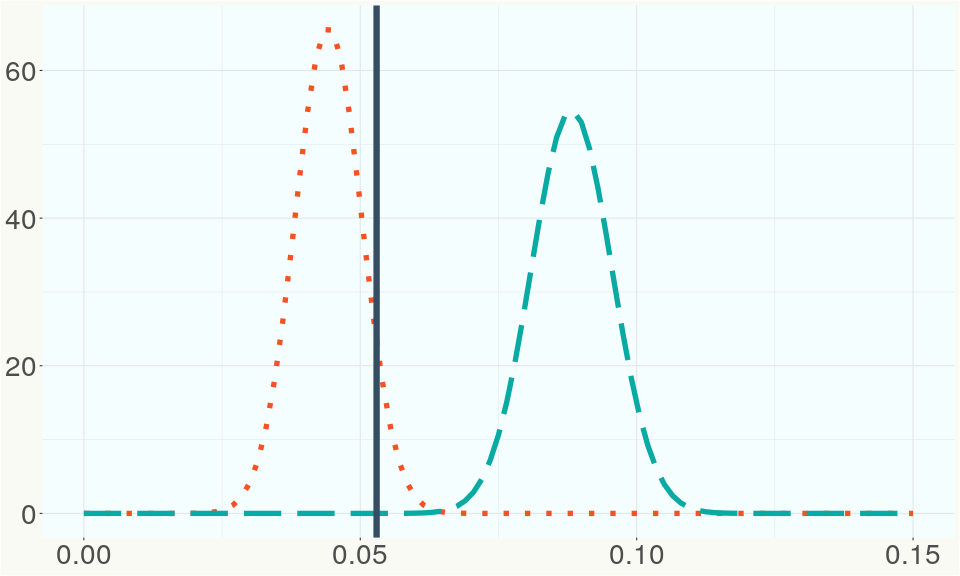
This chart represents the Illumina sequence coverage over the Bt/Bd allele. These are the three regions in the cannabis genome that impact THCA, CBDA, CBGA production. Coverage over the Active CBDAS gene is highly correlated with Type II and Type III plants as described by Etienne de Meijer. Coverage over the THCA gene is highly correlated with Type I and Type II plants but is anti-correlated with Type III plants. Type I plants require coverage over the inactive CBDA loci and no coverage over the Active CBDA gene. Lack of coverage over the Active CBDA and Active THCA allele are presumed to be Type IV plants (CBGA dominant). While deletions of entire THCAS and CBDAS genes are the most common Bt:Bd alleles observed, it is possible to have plants with these genes where functional expression of the enzyme is disrupted by deactivating point mutations (Kojoma et al. 2006).
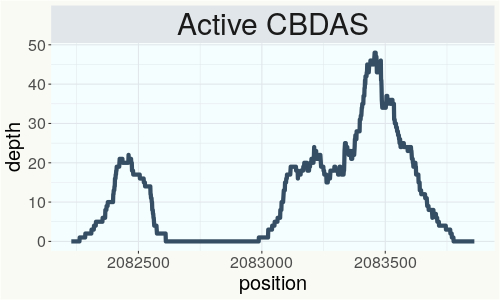
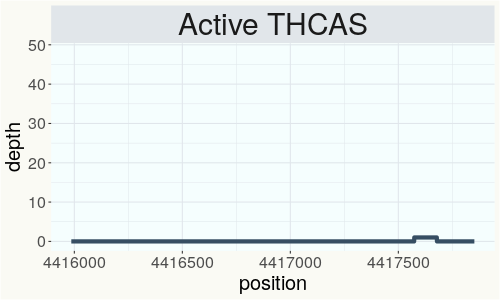
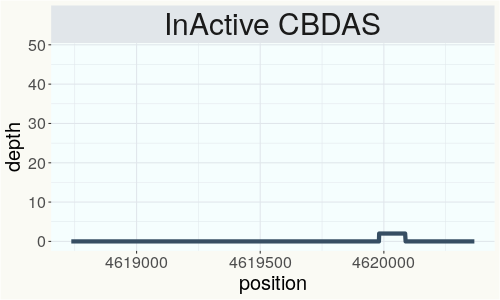
This chart represents the Illumina sequence coverage over the CBCA synthase gene.
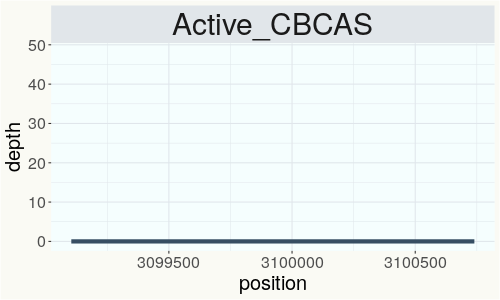
Variants (THCAS, CBDAS, and CBCAS)
Variants (Select Genes of Interest)
| PKSG-4a |
c.261_264dup |
p.Met89fs | frameshift variant | high | contig700 | 1937671 | A/AGTAC |
|
| PKSG-4a | c.617A>G | p.Tyr206Cys | missense variant | moderate | contig700 | 1938028 | A/G |
|
| PKSG-4a |
c.626_628del |
p.Asn209del | disruptive inframe deletion | moderate | contig700 | 1938032 | CAAT/C |
|
| PKSG-4a |
c.1191_1193d |
p.Tyr398del | disruptive inframe deletion | moderate | contig700 | 1938600 | AATT/A |
|
| PKSG-2a | c.948T>G | p.Asp316Glu | missense variant | moderate | contig700 | 1944442 | A/C |
|
| PKSG-2a | c.945T>G | p.Ser315Arg | missense variant | moderate | contig700 | 1944445 | A/C |
|
| PKSG-2a | c.944G>A | p.Ser315Asn | missense variant | moderate | contig700 | 1944446 | C/T |
|
| PKSG-2a | c.934C>G | p.His312Asp | missense variant | moderate | contig700 | 1944456 | G/C |
|
| PKSG-2a | c.67T>A | p.Phe23Ile | missense variant | moderate | contig700 | 1945567 | A/T | |
| PKSG-2b | c.67A>T | p.Ile23Phe | missense variant | moderate | contig700 | 1951815 | T/A | |
| PKSG-2b | c.31A>T | p.Thr11Ser | missense variant | moderate | contig700 | 1951851 | T/A | |
| PKSG-4b | c.496A>G | p.Lys166Glu | missense variant | moderate | contig700 | 2721177 | T/C | |
| PKSG-4b | c.489delT | p.Phe163fs | frameshift variant | high | contig700 | 2721183 | CA/C | |
| PKSG-4b | c.485A>G | p.Lys162Arg | missense variant | moderate | contig700 | 2721188 | T/C | |
| PKSG-4b | c.431T>G | p.Val144Gly | missense variant | moderate | contig700 | 2721242 | A/C | |
| aPT4 |
c.235_236del |
p.Val79fs | frameshift variant | high | contig121 | 2829030 | ATG/A |
|
| aPT4 | c.238delT | p.Ser80fs | frameshift variant | high | contig121 | 2829034 | AT/A |
|
| aPT4 | c.517A>T | p.Ile173Leu | missense variant & splice region variant | moderate | contig121 | 2830795 | A/T |
|
| aPT4 | c.757G>T | p.Val253Leu | missense variant | moderate | contig121 | 2831364 | G/T |
|
| aPT4 | c.1168T>C | p.Tyr390His | missense variant | moderate | contig121 | 2833503 | T/C |
|
| aPT1 |
c.95_97delGT |
p.Cys32del | disruptive inframe deletion | moderate | contig121 | 2835800 | ATGT/A | |
| aPT1 | c.406A>G | p.Ile136Val | missense variant | moderate | contig121 | 2839605 | A/G | |
| aPT1 | c.727G>T | p.Glu243* | stop gained | high | contig121 | 2841362 | G/T | |
| HDS-2 |
c.82_93delGT |
p.Val28_Thr3 |
conservative inframe deletion | moderate | contig95 | 1989748 |
CGTAACCGGAAC |
|
| HDS-2 | c.679G>C | p.Gly227Arg | missense variant | moderate | contig95 | 1990632 | G/C |
|
Nearest genetic relatives (All Samples)
- 0.180 Santhica27 (RSP10056)
- 0.184 Ferimon 12 (SRR14708233)
- 0.192 Santhica 27 (RSP10665)
- 0.193 USO31 (RSP10233)
- 0.194 R1in136 (SRR14708227)
- 0.194 USO 31 (RSP10983)
- 0.196 Futura 75 (RSP10664)
- 0.197 Bialobrzeskie (SRR14708244)
- 0.197 Beniko (SRR14708275)
- 0.199 Lovrin (RSP10658)
- 0.199 Santhica27 (RSP11046)
- 0.199 VIR 223 - Bernburgskaya Odnodomnaya - bm (SRR14708217)
- 0.205 R1in136 (SRR14708226)
- 0.205 Santhica27 (RSP11047)
- 0.206 Delta-llosa (SRR14708272)
- 0.208 Fedora 17 (RSP11203)
- 0.209 USO 31 (RSP10981)
- 0.210 Fedora 17 (RSP10661)
- 0.211 Fedora 17 (SRR14708222)
- 0.211 Juso14 (SRR14708259)
Most genetically distant strains (All Samples)
- 0.452 Cherry Blossom (RSP11300)
- 0.443 Cherry Blossom (RSP11301)
- 0.443 Cherry Blossom (RSP11318)
- 0.442 Cherry Blossom (RSP11311)
- 0.442 Cherry Blossom (RSP11312)
- 0.429 Cherry Blossom (RSP11331)
- 0.426 JL Cross 11 (RSP11512)
- 0.426 Cherry Blossom (RSP11323)
- 0.423 GG4 (RSP11978)
- 0.423 UP Wendigo (RSP11261)
- 0.423 New York City Deisel (RSP11225)
- 0.421 Chem 91 (RSP11185)
- 0.421 Unknown--Cherry Wine---001- (RSP11268)
- 0.420 JL Cross 10 (RSP11511)
- 0.420 Medxotic (RSP11410)
- 0.417 QLE1 (RSP11451)
- 0.416 Cherry Blossom (RSP11298)
- 0.416 GG#4 (RSP11461)
- 0.415 Queen Dream CBG (RSP11295)
- 0.415 Cherry Blossom (RSP11328)
Nearest genetic relative in Phylos dataset
- Overlapping SNPs:
- 113
- Concordance:
- 81
Nearest genetic relative in Lynch dataset
- Overlapping SNPs:
- 17
- Concordance:
- 15
Blockchain Registration Information
- Transaction ID
-
413a5ce57542e7fb
b20d4a69ef0a7519 98e2477d955b29e2 58747c06ec9c8e50 - Stamping Certificate
- Download PDF (851.2 KB)
- SHASUM Hash
-
ef0d19fb06464992023403e3ee5a71ee b9703652d78382fa e491ca5f5f5b74a2